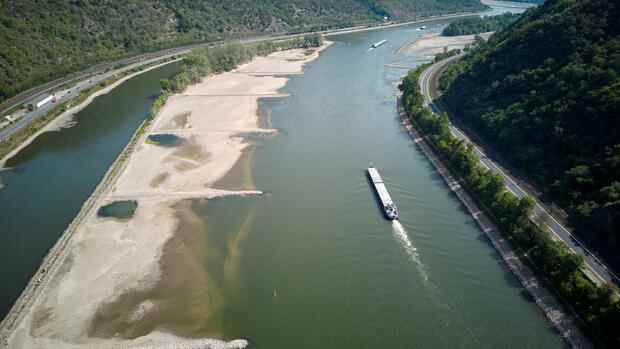The rain wasn’t enough to push the water levels up.
(Photo: IMAGO/Sascha Ditscher)
Dusseldorf Despite the heavy rainfall in southern Germany last Thursday, the situation on Germany’s waterways remains tense. This is shown by the current water levels on the Rhine.
In Iffezheim near the Black Forest, the level initially rose by 38 centimeters due to the precipitation, but has since fallen again by 24 centimeters. The wave caused by the rain reached Worms by Friday noon, while south of Koblenz in Kaub – the lowest point of the river – the level was only 33 centimeters.
The bottleneck near the Loreley thus remains critical for shipping on the Rhine. Because the depth of the fairway there is only 1.12 meters above the water level at 1.45 meters. However, fully loaded cargo ships on the Rhine sink 2.50 to 4.50 meters deep, and they also have to maintain a safety distance of a further 20 to 30 centimeters from the bottom.
Also on the Dutch border near Emmerich, where the level at times even fell just below zero and is currently one centimeter, only lightly loaded ships can pass. The fairway there is only 1.97 meters deep, and the river is only half as wide as usual at 150 meters. This makes ship overhauls difficult.
Top jobs of the day
Find the best jobs now and
be notified by email.
The shipping companies must therefore become creative in the meantime. The container transporter Contargo, a subsidiary of the Westphalian family group Rethmann, has started loading the steel boxes onto the train in Mannheim in the past few days in order to transport them by rail to the ports of Duisburg and Emmerich on the Lower Rhine. “So far, this has only happened in isolated cases,” says a spokeswoman. “Now Contargo is planning to make this solution regular traffic.”
Water level is not the same as water depth
She immediately states the reason: “The low water will last for quite a while.” The Duisburg container hinterland logistics company is talking about at least two to three weeks. But the railways are also plagued by enormous transport problems. Countless construction sites, high levels of sick leave and a lack of wagon capacity place narrow limits on switching to rail.
>> Read about this: Rhine level is sinking lower and lower: Bahn fails as a savior in the event of delivery bottlenecks
A few days ago, Steffen Bauer, head of Europe’s largest inland waterway logistics company HGK, warned of supply bottlenecks at gas stations in southern Germany. Now it even affects a large refinery much further down the Rhine on the Lower Rhine.
Shell needs to cut fuel production
“Due to the low water level of the Rhine, we have reduced the capacity of the Shell Energy and Chemicals Park Rheinland,” operator Shell Plc said by email on Thursday. The supply situation is difficult, the company explained when asked about delivery restrictions for customers. Fuels, heating oil and petrochemicals are manufactured there.
The chemical park is located on the left bank of the Rhine between Cologne and Bonn, where HGK boss Bauer had classified disruptions as unlikely a few days ago. However, the water level near Bonn, at 86 centimetres, is only five centimeters from its historically lowest water level, and the fairway depth is an alarming 1.95 metres.
The nearby refinery complex consists of the Godorf and Wesseling plants, which together have a crude oil processing capacity of just over 320,000 barrels per day, according to Bloomberg news agency. Europe’s largest refinery, Shell Pernis in Rotterdam, processes 400,000 barrels of crude oil a day.
Unusually early low water – and no improvement in sight
According to the Rhine Waterways and Shipping Authority (WSV), the water level in the entire Middle and Lower Rhine remains at a relatively constant but extremely low level. “Within the next few days, the water levels will rise again in the entire Rhine catchment area due to the announced precipitation,” the authority said on Friday. The 14-day forecast indicates that water levels will rise by about half a meter by the end of next week, but will subside after the wave passes.
The medium-term water levels on the Middle and Lower Rhine remain at an exceptionally low level for this time of year. There has largely been no precipitation in the past few weeks and months.
“Actually, September is always the typical low-water month on the Rhine,” reports HGK boss Bauer. The record low water in 2018, when the water level at Kaub dropped to 25 centimetres, only hit inland waterway skippers in October.
More: Retail is already starting Christmas shopping – the first shipowners have to rearrange containers
